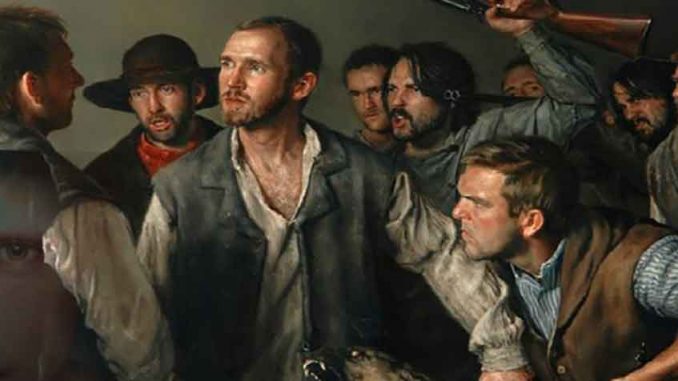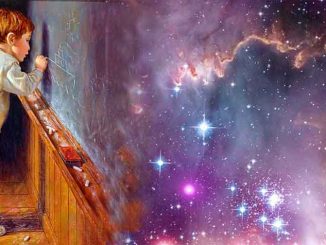
Often the Lord introduces his word as a sword that «…is quick and powerful, sharper than a two-edged sword, to the dividing asunder of the joints and marrow, soul and spirit…» (D&C 33:1). In this image his word acts as much in our body as in the soul and the pain of its contractures.
Likewise, the plan of salvation is experienced in the body, wounded by disease or in the soul pierced by sorrow. Basically, our state is probative. The Gospel constitutes the balm to alleviate this permanent friction with the world. And it does so by taking care of the body and healing the soul.

Jacob, someone experienced in pain since his childhood, speaks to us of «…many hearts died, pierced with deep wounds.» (Jacob 2:35) Nevertheless, he warns us that «the pride of [our hearts] destroys our souls! That complex system of «joints and marrow» of our body is as difficult to understand as sometimes the origin of the soul’s pain «Although affliction cometh not forth of the dust, neither doth trouble spring out of the ground.» (Job 5:6)
For some mysterious reason we consider pain as an interruption of our life. We do not accept its turbulence as part of the path. Suffering seems to us an unnatural position of our joints and dejection, a strange order of our emotions. Then we want to go back to Eden, and from there we leave without a cultivated soul. We were gatherers, just like the creatures that populated it. Our relationship with the earth was childish.
The fall was a great contracture in our soul. Pain has been with us ever since and reminds us of the muscular and mental burden of dealing with the world and its fallen state on a daily basis. The effort to sustain us, when the whole Universe conspires for our destruction, is sometimes exhausting.
Abraham in the face of contradiction

The patriarchal order in Abraham’s family was intensified in Isaac, being the only son of the covenant. All faith and hope were in him. Upon receiving the commandment «Take now thy son, thine only son Isaac, whom thou lovest, and get thee into the land of Moriah; and offer him there for a burnt offering upon one of the mountains which I will tell thee of.». (Genesis 22:1) With this commandment all the fibers in Abraham’s soul are subjected to a change in their braid. In his eyes it is the great contradiction. An alignment with an unknown and painful trace. A direction contrary to the articular movements of his soul in righteousness.
There is no previous contracture in Abraham’s soul. His whole body and soul is formed in the image of Jehovah’s law. Why this painful and contradictory trial to the direction followed?
At the moment of raising the knife to slit Isaac’s throat, perhaps he remembered an episode of his youth with a priest of Pharaoh.
«And as they lifted up their hands upon me, that they might offer me up and take away my life, behold, I lifted up my voice unto the Lord my God, and the Lord hearkened and heard, and he filled me with the vision of the Almighty, and the angel of his presence stood by me, and immediately unloosed my bands» (Abraham 1:15)
The one who sought «to be a father of many nations, a prince of peace» (2) now acted as a priest of Elkénah, in his hand a similar knife and under him, an innocent young man, his living image.
Moriah, July 1843

Plural marriage was the great torsion in the souls of the saints. Those of the twentieth century who, like Abraham, corresponded with their conduct to the commandments of God, sacrificed the matrimonial order and the peace they knew. Speaking to my students in high school class, a certain perplexity was evident, more accentuated in young women studying section 132.
Both in the twentieth century and now, that order of marriage does not correspond to the world in which we live. It does not fit into our form of society and does not obey some visible motive or need. For those saints, at first sight, that was something as immoral as sacrificing a child.
Now, dear reader, before I consider my words inappropriate and hostile, I would like to clarify something. Political correctness (that abominable church) teaches us to perform a maneuver of mental dodging in the face of reality that we don’t understand or that bothers us. But to take up our cross means to face the incomprehensible in a perpendicular way.
Saints sometimes think that the gospel is not strong enough to withstand our strong doubts. And instead of offering them in prayer and study, we hide them as imperfect offerings. We feel guilty for having doubts, we almost convince ourselves that they do not exist.
But to take up our cross is to carry what we know and what we do not know. Accepting the understandable and the incomprehensible. Plural marriage is one of our Moriah. On this mountain we all sacrifice logic, common sense and our belonging to the generation of our century. But let’s not forget something, that stage of our history was not a mistake, Wilford Woodroff did not rectify, but adopted the Lord’s strategy in the great game of chess against the adversary.
Some considerations

At the beginning of each dispensation an extension in the joints of the soul into new movements is required. Abraham had to learn that God is not a subject of right but a source of right. Moses had to teach a nation of slaves to be free men. The Savior led us to salvation by His mercy and not by the law. The early Christians found it very difficult to extend their arms and joints to the Gentiles. Accepting an Israel spread throughout the world subjected them to a painful extension of their mentality, to being unassisted for a local reason, unable to face a universal challenge. In all dispensations it is necessary to uncoordinate the way of being. Just as the priest did with the offering at the altar. We cannot attain the stature of Christ without changing our form.
What about Latter-day Saints?
The fullness of the gospel requires a fullness of movement. Some of them are new and painful. In that sense the bodies and minds of this dispensation are vivified by the light of fullness. And that sometimes brings strange and incomprehensible landscapes.
When Jesus talks to Nicodemus about being born again, Nicodemus asks two questions.
«How can a man be born when he is old? can he enter the second time into his mother’s womb, and be born?» (John 3:4)
If we meditate on them, the first emerges from his soul and the second from his mind. The structure of the first question denotes a sincere and promising doubt. It may lead him to foreshadow another form of birth. In contrast, the second question is generated by a Jewish mind of its time. He improvises answers and follows a literal course «after the manner of the things of the Jews» (2 Nephi 25:5). The statement of that question opens the furrow of his answer in the direction of a great stone.
Restoration and its torsions
In this scene with Nicodemus, we see the Savior’s challenge. To unburden the stiff joints of a mentality limited by the rigidity of the scribes.
In our case, the saints start from advanced, but culturally disjointed societies. Any proposal of link or agreement is put under suspicion, like limitation of movements in the personal thing. As a Spanish and European citizen I see that the tendency towards individualism is growing. Few couples get married and the number of children plummets.

The new and everlasting covenant of marriage, whose facet of plural marriage is a part and not the whole, contradicts the current of our century. The saints, as inhabitants of this century, sometimes tend to ask the questions of Nicodemus. To approach the matter from an advanced western mentality.
From there, indeed, the new convention is an anachronism. However, restoration and its fullness do not belong to our space or to its time because «… it was instituted for the fulness of [its] glory». (D&C 132:6). For that reason our mental schemes, which are affected to some degree by gender ideology and other current trends, cannot interpret restoration correctly. To put it like Nephi «after the manner of things of the westerners,» Abraham would be a maltreater and Moses a dictator.
However, the restoration takes us to a different environment. There are no referents in our world, we are not served by the optics of the present. Hence the Savior’s response to Nicodemus:
«If I have told you earthly things, and ye believe not, how shall ye believe, if I tell you of heavenly things?» (John 3:12) The world wants the kingdom of heaven to become a democratic republic. But his gospel calls all to be kings and queens, priests and priestesses. An ancient order of government.
The passionate gospel
When I was young, I was afraid to think about evolution. I considered my doubts about our well-formed divine origin. I observed my faith perfectly besieged by the facts. I was also perplexed to see a supposed Eden in the hands of prestigious ideologies, contrary to the Gospel. No escape. I had the company of a bearable pain, but permanent in a place, there inside of me. Yes, I was like that, in that and in other things.

To give reason what is hers and God what is God’s is a tensegrity posture. Restoration harnesses the impulse of reason to achieve the goals of the gospel it administers. Technology in general and information technology or I.A. in particular are part of the mechanisms of Israel’s recollection. In giving to Caesar what is Caesar’s, the early Christians used the Roman roadways to spread the good news. We use digital means to extend recollection. Therefore as a church and as end-time saints we cannot open our hands to the achievements of the world and close our ears to the people who inhabit it. To be scandalized, therefore, should not be in the repertoire of our attitudes, but that of understanding, inviting, and a well-understood condescension.
As Jung said .
[su_note note_color=»#caecef» text_color=»#401919″ radius=»8″]»Any tree that wants to touch the sky needs to have such deep roots to the point of touching hell.». Carl Jung, [/su_note]
Lehi also taught « For it must needs be, that there is an opposition in all things.»(2 Nephi 2:11) Therefore the fullness of the gospel has to face the fullness of the adversary. We saints have to face the fact of almost touching with our roots the powerful arguments of the great building.
The soul and the pain of its contractures

This posture will inevitably show us the soul and pain of your contractures. Participating as a church in the world «to build with our own hands» (Alma 32;5) yet we often feel that we are «cast out of the synagogues because of the coarseness of [our] apparel.» (2)
That is why we must accept the challenge that represents «[widen our] heart as the breadth of eternity» (Moses 7:41) so that just as Moses [sees its inhabitants; and there is not a single soul that we do not see; and discern them by the Spirit of God] (Moses 1:28) In this new expansion of recollection, as in ancient times, we contact the fullness of the world and its inhabitants.
Now, situated on the crest of this dispensation, we shall come in the fullness of the Gospel to the fullness of the lost tribes of Israel. We will explore the souls of all men and the «perplexities of the nations.» But first we must experience the pain of abandoning our former form and its questions ill-formed by the stature of Christ. He who being pure ate and drank with sinners without being scandalized.
That is the sacred pain of one who does not dodge the altar and offer his mind and heart. Without knowing for sure if the knife will come down or not.
Asterión

Thomas Moore, a soul therapist, comments on an episode from Greek mythology.
«The Greeks told the story of the Minotaur, the man with the head of a bull who ate human flesh and lived in the center of the labyrinth. Despite being a threatening beast, his name was Asterion, which means star. I often think of this paradox as I stand next to someone with tears in their eyes, looking to face death, divorce, or depression. What shakes in the very center of her being is a beast, but it is also the star of her most intimate nature.
We have to look after this suffering with great reverence, so that the fear and anger that the beast provokes in us does not make us lose sight of the star».
Thomas Moore, The Care of the Soul.
The ancient minotaur in the center of each saint’s labyrinth hides the star inside.




Be the first to comment